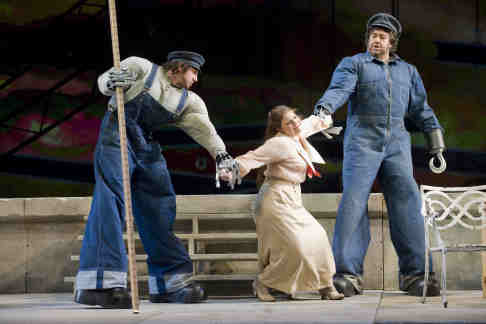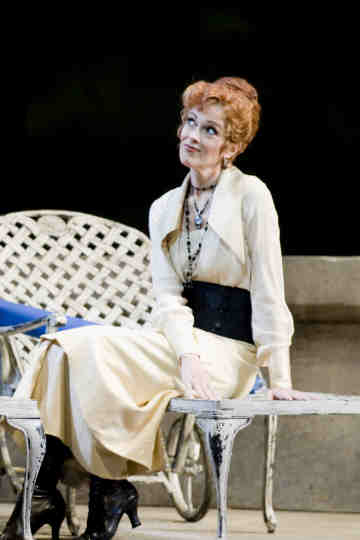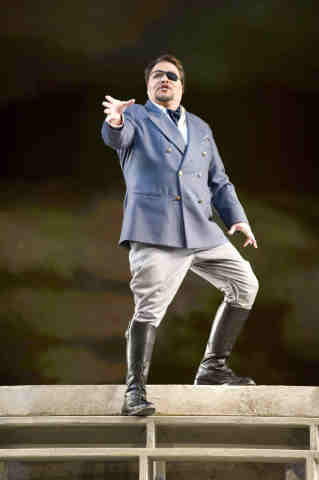Other Links
Editorial Board
- Editor - Bill Kenny
- London Editor-Melanie Eskenazi
- Founder - Len Mullenger
Google Site Search
SEEN
AND HEARD INTERNATIONAL OPERA REVIEW
Wagner, Das Rheingold: New production. Francesca Zambello, producer. Soloists, chorus and orchestra San Francisco
Opera, Donald Runnicles conductor. 3.6.2008. (MM)

The Giants and Freia
One wishes, but only every so often, for the good old days when a Ring was a very special event. Now it seems the Ring may have overtaken Aida as the most produced mega-opera, at least among the big companies around the world. This does gives us the advantage of seeing it in many different ways, clarifying its mysteries, laying bare its weaknesses, with the result that one approaches any new Ring with skepticism rather than blind enthusiasm.
Das Rheingold is surely the producers nightmare of the four, as it has eleven roles requiring major voices, not including the Rhine maidens. One should expect any major American company to ably fill these spots, as San Francisco Opera has done though without great distinction. At the same time Rheingold has little of the musical-emotional payoff we expect from Walküre and Götterdämmerung thus it generates less excitement at the box office. There was the disappointment of visible empty seats at its opening.
Nonetheless the Eb major rumble of the Rhine never fails too ignite shivers of anticipation for the huge and indeed magical exposition to come of the nineteenth century's socio-economic intrigues, and Wagner's effective but naïve denouement. San Francisco's gold rush was simultaneous with the genesis of Wagner's Ring treatise, thus the famous prelude seemed to belong in San Francisco and in its opera house, the gray, gold and pale blue colors like the Sierras. Viewed from the opera house's grand tier gold lights bounced from the reflecting surfaces of the polished woods of the strings and the luster of the silver and brass instruments, seeming to betray the placement of the Rhine gold.

Jennifer Larmore as Fricka
Once
these initial conceptual shivers had dissipated we were left with a
scrim on which throbbed two dimensional colors, lots of them, naively
illustrating Wagner's river. Moving into the river generated some
excitement, with a transparent blue floor, three gold clad river
nymphs, and a huge black and white projection of a mountain stream
tumbling over stones. Maybe this is the Sierras and
San Francisco will be Valhalla: there was another conceptual shiver and more fog
than ever before flowed onto the War Memorial Opera House stage. Alberich appeared slipping and sliding on the damp stones, dressed as
a forty-niner, a strong, physical performer, Richard Paul Fink.
Alberich and the Rhine maidens ceremoniously floated a large gold
silk cloth around the stage, then Alberich wrapped himself in it and
fled the stage.
The
temporary residence of the gods was filled with lounge chairs,
tables, architects' blue prints, one had the impression that it might
even be a construction trailer or a trailer park. Its inhabitants,
Teutonic gods, were trailer-trash even if dressed in what appeared to be
post-Victorian garb. Within this context there were excellent
performances, Jennifer Larmore as a truly convincing trailer-class
Fricka, Jason Collins and Charles Taylor were the handsomely voiced,
handsome, if no-good hangers-on Froh and Donner. Tamara Wapinsky
made a vibrant, beautifully sung and acted, adolescent Freia.
Mark Delavan was the appropriately vain, thin-voiced,
head-of-household Wotan. The several extended family squabbles of Das
Rheingold unfolded in sometimes amusing, always un-focused
staging.

Mark Delavan as Wotan
Adding yet another dimension Fasolt and Fafner were giant cartoon characters complete with stainless steel fingers. Descending from the steel beam construction of this dysfunctional family's new high-rise dream home, the sympathetic Andrea Silvestrelli (Fasolt) and the rough G
ünther Groissböck (Fafner) were comic book heros. The sleazy story unfolded as it always does in the lively, well staged Nibelheim scene with some fine, if perhaps too cheap Disney special effects. The especially effective Loge of Stefan Margita brought the sparks of intrigue and deception that define some of those seedy friends we all have, particularly those of us who live in trailer parks.The real, the mythical, the symbolic, and the cartoon were intermixed in the production's storytelling. Two dimensional, color saturated projections on an upstage scrim sometimes illustrated the story while flat colorful shapes throbbed on the downstage scrim during the orchestrally accompanied scene changes. These scene shifts introduced a further dimension as back-stage shouting emerged through the scrim and over the orchestra, a rich idea that enhanced the duties of the underworld Nibelungen. When visible on-stage the Nibelungen were not these vocal stagehands but an impressive group of children that added piercing squeals from time to time. If there was no shortage of ideas or means to realize them in this production, there was the suspicion that this was but a list of ideas, not a production concept.
Though Freia had expressed real regret at being separated from Fasolt she is reconciled to the trailer-trash gods, and finally all ascended a gangplank, clinking their glasses of champagne, presumably climbing towards the next episode of their story, or onto a cruise, or something.
Through all of this the San Francisco Opera Orchestra delivered Wagner's score from the eloquent pit, Donald Runnicles at the helm. It is an excellent orchestra, expanded for Wagnerian requirements, amply fulfilling all musical requirements in a hall sympathetic to large orchestral sound. Runnicles is famed for Wagner, and if this Rheingold's musical points were seemingly pallid it was perhaps because the stage was not sure what it was doing.
Of important note is that prior to the performance we were spared the condescending exhortation to seek out our route to the nearest exit (though many of the audience perhaps wished they had had a way out during this performance). Of more important note is that the stage director and designers did not take bows. Millions of dollars and massive energy were expended on this production, and as we, the audience needed to express our appreciation to the performers for their work we also needed to express our appreciation, or lack of, to the producers, here left unmentioned as they apparently preferred to remain anonymous.
Michael Milenski
Photos ©Terence McCarthy : courtesy of San Francisco Opera
Back to Top Cumulative Index Page
